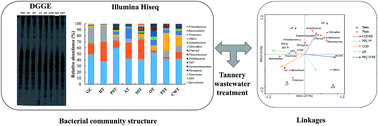Evolution of bacterial consortia in an integrated tannery wastewater treatment process†
Abstract
In the present study, the dynamics of microbial communities and their abundance associated with each stage of a tannery wastewater treatment process were investigated by polymerase chain reaction-denaturing gradient gel electrophoresis (PCR-DGGE) combined with high throughput sequencing. Both PCR-DGGE and high throughput sequencing results reflected the bacterial succession in the integrated treatment process and phyla of Proteobacteria, Bacteroidetes and Firmicutes dominated throughout the integrated treatment process. However, Actinobacteria, Planctomycetes and Chlofoflexi only predominant the anoxic/oxic (A/O) process. The bacterial richness during the A/O process was higher than that in the pre-treatment process. Moreover, quantitative polymerase chain reaction (qPCR) analysis indicated that the absolute abundance of 16S rRNA genes in the biological treatment stages were higher than in other stages. Finally, redundancy analysis suggested that [Thermi] should be involved in NH4+–N removal and ammonia concentration had positive effects on the bacterial diversity. Overall, this study provided insight into the evolution of the bacterial community structure and diversity in integrated wastewater treatment processes and identified the correlations between the physicochemical characteristics of wastewater and bacterial community structures.


 Please wait while we load your content...
Please wait while we load your content...